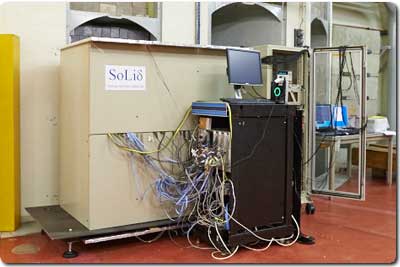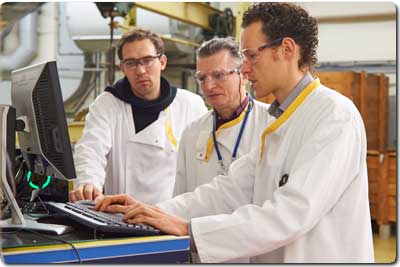
Belgian scientists harness latest technology in search for elementary particles
Sterile neutrinos; the next ‘big’ thing
Elementary particles, and the quest to discover them, have never been ‘hotter’. The Higgs Boson became a global sensation, and the men who predicted its existence won the Nobel Prize for Physics. Now Belgian scientists are turning their attention to the next big thing: sterile neutrinos. With the help of French and British colleagues, they are using a revolutionary technology to record evidence that these particles exist.

Two French and two British universities, together with the Flemish universities of Antwerp, Gent and the VUB (the Flemish Free University of Brussels), joined forces in early 2013 with Belgium‘s Nuclear Research Centre (SCK•CEN, in Mol), to form a European research consortium. Together, they have developed a ‘neutrino experiment’. The project is called SOLID, which stands for Search for Oscillations with a Lithium6 Detector.
The scientists involved want to record sterile neutrinos. “These elementary particles may be linked to the particle whose discovery earned Belgian François Englert and Briton Peter Higgs the Nobel Prize for physics in 2013,” says Professor Nick van Remortel (UAntwerp). “If these new elementary particles are actually found, it will immediately answer many fundamental questions about the origin of mass and the stability of the universe.”
Very weak interaction
There is no doubt that neutrinos exist. These elementary particles were first discovered in the 1950s at a US nuclear reactor at Savannah River, South Carolina. They are also produced in vast quantities inside the sun. They are very difficult to record, however, because they barely interact with matter. Every second, about 50 billion neutrinos pass through every square centimetre of our bodies without us ever noticing.

By 2016, scientists hope to build a neutrino detector, weighing over two tonnes, which will be used to look for these sterile neutrinos over a period of three years. The scientists, including several Oxford researchers, are using a new type of particle detector: one that is extremely sensitive to neutrinos. Van Remortel: “This absolutely revolutionary technology could even be used for the remote detection of nuclear activity worldwide — a very interesting way of verifying compliance with non-proliferation agreements.”
International race
The particle detector will be built near the BR2 research reactor at SCK•CEN in Mol, Belgium. This reactor, which is responsible for a large proportion of the global production of medical radioisotopes used for imaging and cancer therapy, also appears to be ideal for carrying out fundamental research into the field of elementary particles.
"We are proud to be able to use our expertise and our BR2 facility — unique in this respect — to contribute to the success of this very exciting project", says Professor Eric van Walle, Director-General of SCK•CEN. “This search for sterile neutrinos shows that our institution can offer very interesting prospects for developing and expanding this type of fundamental research.”
The experiment has been made possible partly thanks to financial support from the Fund for Scientific Research Flanders, the Hercules Foundation and Belspo. “This project demonstrates that research centres such as SCK•CEN have top-level research facilities and technical expertise, allowing them to compete with the world’s major research institutions. This means we are well equipped for this race, because other consortiums around the world are also looking for sterile neutrinos,” added Professor Van Remortel.
BR2 reactor
BR2, short for Belgian Reactor 2, is one of the most powerful research reactors in the world. It is water-cooled and has been used since 1962 as a test reactor for fuels and reactor materials for various reactor types. BR2 is also one of the most important producers of medical radioisotopes used for diagnosis and therapy, including the most commonly used isotope, molybdenum-99. The reactor produces 25% of world demand every year, and up to 65% at peak times. BR2 is also used to irradiate silicon, a process which results in a semiconducting material of excellent quality. These semiconductors are essential components of the electronics in solar and wind energy systems and in hybrid and electric vehicles.
Sterile neutrinos
A neutrino is an elementary particle with no electric charge, produced in high-energy collisions between nucleons. Scientists suspect that neutrinos have almost no mass. Only very rarely do they collide with matter; most of the time, they simply pass right through it. Detecting ordinary neutrinos is hard enough as it is, but sterile neutrinos are even more elusive. Particle physicists believe that they may even be able to solve the mystery surrounding dark matter if they manage to observe sterile neutrinos.
Contact information:
University of Antwerp
Prof Nick van Remortel
nick.vanremortel@uantwerpen.be
+32 (0) 3 265 35 68, +32 (0) 475 84 16 01
Belgian Nuclear Research Centre, SCK•CEN
Prof Dr. Eric van Walle, director-general
Eric.van.walle@sckcen.be
014 33 25 90
Ghent University
Prof Dirk Ryckbosch
Dirk.Ryckbosch@UGent.be
+32 (0) 9 264 65 43, +32 (0) 494 84 21 58
Vrije Universiteit Brussel
Prof Petra Van Mulders
pvmulder@vub.ac.be
+32 (0) 2 629 36 23, +32 (0) 498 59 10 65
|

